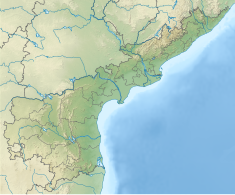| Dowleswaram Barrage | |
|---|---|
 Sir Arthur Cotton Barrage, Dowleswaram | |
| Country | India |
| Location | Dowleswaram, Rajamahendravaram, Andhra Pradesh |
| Coordinates | 16°55′51″N81°45′57″E / 16.9307594°N 81.7657988°E |
| Purpose | Irrigation, water supply |
| Status | Operational |
| Construction began | 1847 |
| Opening date | 1852 |
| Owner(s) | Government of Andhra Pradesh |
| Dam and spillways | |
| Type of dam | Barrage |
| Impounds | Godavari River |
| Length | 3,599 m [1] |
| Website irrigationap | |

The Dowleswaram Barrage was an irrigation structure originally built in 1852 by Sir Arthur Cotton on the lower stretch of the Godavari River before it empties into the Bay of Bengal. Retrofitting was done in 1970, and it was officially renamed as Sir Arthur Cotton Barrage, also known as DowleswaramBarrage. [1]





